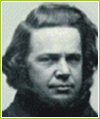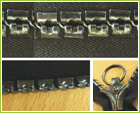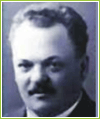|
The
Zipper
1851 Elias Howe Sometimes we fail to realize the true
potential and let it pass by. It happened to Elias Howe, when
he invented the sewing machine along with an automatic, continuous
clothing closure. The sewing machine turned out to be a resounding
success but he dint pursue marketing of the closing closure,
which resulted in an opportunity loss. |
 |
|
1893 Whitcomb
L Judson The idea of clothing closures or fasteners
was pursued passionately by Whitcomb L. Judson and it was
patented to him in United States of America. He was rewarded
with the title 'Father of the Zipper' which was narrowly missed
by Elias Howe.
It may be amusing to know that Judson invented the slide fastener
thanks to his friends stiff back, who couldn't do up his shoes.
Judson came up with slide fastener that could be opened and
closed with one hand. Later it proved to be useful. |
 |
|
1905 The C-Curity
Fastner Made of Thin Sheets of Steel, the automatic
hook and eye fastener allowed free movement as it was clamped
together with right spacing. When it was used on ladies' garments
it was called Placket Fastener. |
 |
|
1913 Gideon Sundback
Immigrating from Sweden to Canada, Sundback
joined the Universal Fastener Company. There he worked on
improving the Judson C-Curity Fasetner and designed the modern
zipper. Earning him the recognition of having invented the
modern zipper. He also introduced innovations like automatic
hook, flexible fastener and a new eye, termed 'Plako' to the
Judson design.
Sundback patented his first hook-less separable fastener in
the USA in 1917 which became the foundation patent for the
zipper industry.
Sundback was also the inventor of the Scoop used in garments,
bags, trousers and aviation suits. He continued the good work
with S-L Zipper Machine, models of varying size (#4, #5 and
#6 in 1922), giving more flexibility to users. |
 |
|
The Zipper The B. F. Goodrich company used fasteners
on tobacco pouches and boots and they renamed the good old
fastener as Zipper. The term Zippers came to a popular usage
in America. But exactly why was the fastener called Zip?
To find out, let us closely examine the fastener itself. The
fastener consists of two strips of fabric tape, each carrying
tens or hundreds of specially shaped metal plastic teeth.
Then there is the slider, operated by the hand, riding up
and down the two sets of teeth thanks to a 'Y' shaped channel;
fastening and unfastening. The friction of slider aginst the
teeth cause a characteristic buzzing noise. Most probably
this buzzing noise was the reason why slide fasteners were
called Zippers!
Over the years zippers have transformed from a useful curiosity
to a necessary accessory to clothing and much more. From the
ferocious soldier on the war front to the cool dude chasing
skirts, from the toughest diving suits tot the softest baby
apparel, zippers are everywhere. Adding value and evolving
with mankind. |
|
|
